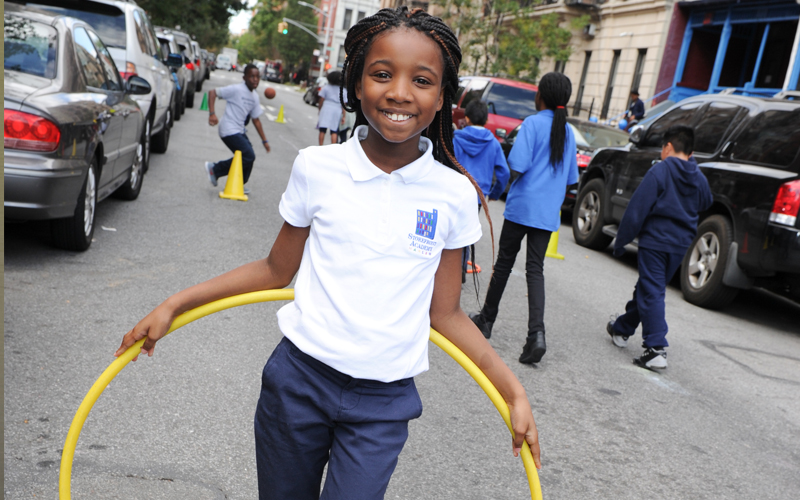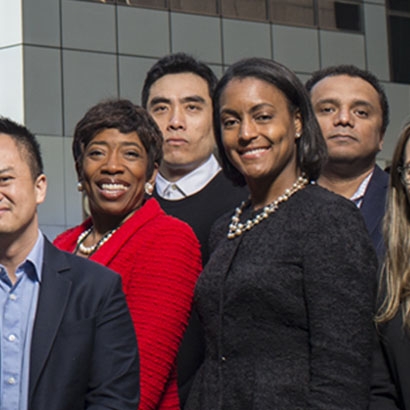Learn how Morgan Stanley and Storefront Academy are celebrating Black History Month. Explore their discussion about the school's teaching philosophy.
Storefront Academy is a small private tuition-free school for 200 black and Hispanic pre-K-8th graders. It sits on the corner of 129th Street and Park Avenue, the heart of Central Harlem, next to elevated railway tracks and with the street as a playground for the older students.
Yet every year hundreds of parents apply to secure a place for their children in the school. Why it’s so popular becomes clear inside. The atmosphere is cozy; children are clearly engrossed and happy at work; teachers are getting hugs from kids in the hallway and its Principal, Alexis Thomason is busy giving life advice to eighth graders in her office. It’s about as far from the Black History Month theme of “black education in crisis” as you could get.
And that’s precisely the point, says Thomason. “Black education is undoubtedly in crisis,” she says. “That’s why we exist, to offer an entirely different approach to education.”
An Alternative to Public School
Storefront Academy is the forerunner of the many public charter schools that now populate the neighborhood. It began in the mid 1960s, when New York-born poet Ned O’Gorman looked for a more nurturing alternative to over-crowded, under-staffed public schools that often were hotbeds of bullying and poor academics. The school initially started as an after school drop off center and eventually morphed into the comprehensive program it is today. It relies entirely on private funding from companies like Morgan Stanley and taps into public services New York City provides for low-income families and at-risk children.
Harlem has gentrified considerably since then, but many of its public schools have fallen behind. “I went to a large public school before I came here,” says 12-year-old Tiara. “I was bullied every day. Everyone is bullied – all the time. It could be for anything, like your mix-and-match earrings.” Tiara’s mother eventually managed to get her into Storefront. Like Tiara’s family, many Harlem residents face a tough choice when it comes to educating their children. They can take their chances on a charter school lottery or leave the neighborhood in search of better zoned public schools.
For the low-income, predominantly black and Hispanic families that comprise the Storefront Academy’s student base, the stresses of living in an increasingly more expensive Manhattan have only worsened as rents and other costs of living have risen. About 80% of the school’s 200-strong student body come from families eligible for free or reduced price lunch. Children of all learning abilities are welcome and integrated into regular classrooms, a bar-raising approach that pays off. Although 60% of Storefront students require special learning support, 95% go on to graduate from high school. That compares with an average 65% high school graduation rate for the public school district in which Central Harlem falls.

“We follow what’s called the ‘whole child’ model,” explains Thomason. “Our philosophy is that children in low-income inner-city neighborhoods face very specific challenges that kids in more affluent areas don’t. We have kids who live with nine other family members in tiny apartments. Rents in Harlem have soared, so there are families that can’t pay the rent or afford to move, and end up living in shelters. When many of the kids first come to us they’re emotionally drained and in their shells.”
Storefront connects families with nonprofits and city-run agencies whose services help children better cope with academics and social encounters at school. The Whole Child model requires emotional, social and academic learning. Storefront focuses on teaching empathy and respect for each other in everyday school life. Pre-Kindergarten to fifth graders learn conflict resolution and how to communicate and support each other. Middle school grades six to eight learn decision-making and goal-setting skills that prevent them from dropping out of high school. Seventh graders get a special course in peer mediation, enabling them to coach younger students on how to resolve arguments or other conflicts.
We know that as African Americans, we often have stereotypes put on us.
Keeping it Real
Girls additionally have “keeping it real” conversations with their teachers and Thomason. “We know that as African Americans, we often have stereotypes put on us — stereotypes that say we are not capable as others,” says Kendra, an eighth grader. “But we also know that when we work hard enough, to our full potential, we will be able to show that the stereotypes are not true.”
Storefront has also built on its long-term relationships with the private sector. Susan Reid, Global Head of Diversity and Inclusion at Morgan Stanley, sits on the school’s board and has introduced programs to provide students with year-long mentoring and networking opportunities. Mentors from Morgan Stanley visit regularly to talk to students about career development and to bolster their self-confidence. Students also visit Morgan Stanley’s headquarters for a day, pairing them with employees in different business groups so they can experience corporate life and develop relationships.
The combination of these experiences can have an extraordinary impact on students’ intellectual advancement. When one little five-year-old came to Storefront two years ago, he was non-verbal. “He just did not talk, at all,” says Thomason. Now he's chatting up a storm. Children who were initially shy and withdrawn are mature negotiators by the age of 12 who know a formal presentation is a good way to show Thomason why a spring dance would be good for the school and how they intend to raise funds for it.
For 13-year-old Yasmeen the benefits of a social, emotional and academic education can be summed up in one word: confidence. “We've learned to be confident. We all want to complete high school and go on to college, and we know we can achieve that as much as anyone else can.”



